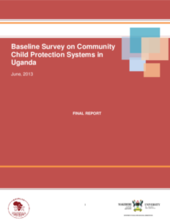This comprehensive report describes the process, findings and recommendations of the baseline survey for a project titled, "Building and Strengthening Community-Based Child Protection Systems in Busoga and Acholi sub-regions" commissioned by the African Network for the Prevention and Protection against Child Abuse and Neglect (ANPPCAN). A large part of the proposed project will focus on prevention work geared towards building the capacity of families and those caring for children to provide a safe environment through initiating parenting discussions, home visits to selected households, strengthening traditional support structures for children and linking communities with the formal child protection structures. Field work for this mixed-method baseline study was conducted in two districts (Jinja and Kitgum) of Uganda between April and May, 2013. A total of 394 children aged 5-17 were interviewed for the quantitative aspects of the research. In addition, 62 children and 111 community members participated in focus group discussions and 22 key informants received in depth interviews, in order to obtain qualitative information. About 7% of the children in the sample had at least one form of disability, 8% of the children were double-orphans, while just over 26% had lost one parent. More than more than a quarter of the children (27%) were not enrolled in school at the time of the survey.
The survey explores children’s perceptions and attitudes on child abuse as well as their experiences of violence, their knowledge and skills to protect themselves, the community’s understanding and perceptions about children protection, harmful traditional cultural practices, and traditional practices of child rearing and child protection in the targeted communities, including parenting practices. It also assesses the effectiveness of locally generated and owned mechanisms for preventing and protecting children from abuse.
Among key findings, nearly half of the children (49%) indicated that child abuse is a serious problem in their community. Eighty-five percent of the children in both Kitgum and Jinja districts of Uganda had experienced at least one form of physical violence. Respectively, 46.2% and 84.3% of the children had experienced some form of sexual and emotional violence in the last 12 months prior to the survey. Only 53 percent of the children reported they could definitely refuse /reject sexual advances, by making appropriate, assertive, and persistent verbal responses. 31.2 percent of children were not aware that strangers were not the only perpetrators of child abuse, and over 40 percent did not know where to report or the procedures for reporting child abuse.
The study identified three important traditional practices that related positively to child protection and wellbeing: "It took a village to raise a child”, with child care rearing considered a communal responsibility; Extended family and the nurturing of children: with extended families traditionally playing a more pronounced role in child nurturing, care and protection, than is the case nowadays; and Idiomatic expressions, taboos and proverbs, that promoted child protection through emphasizing taboos and telling scary stories that deterred children from doing certain things.
It also found that most of the protection and response services are provided within the realm of the community-based and informal child protection system, the functionality of which is fraught with several challenges. In particular, it highlighted that for a range of complex reasons, “many community level structures tend to mishandle serious violations against children such as sexual abuse in a manner that compromises the rights of the affected children.”
Based on these findings, several recommendations for strengthening community-based responses for child protection are suggested. These include the needs to: strengthen the capacity of families to protect and care for children, build children's capacities for self-protection, strengthen and complement the capacity of key community-based child protection actors, and promote more effective linkages between the formal and informal child protection mechanisms.
©ANPPCAN, Makerere University Department of Social Work and Social Administration

